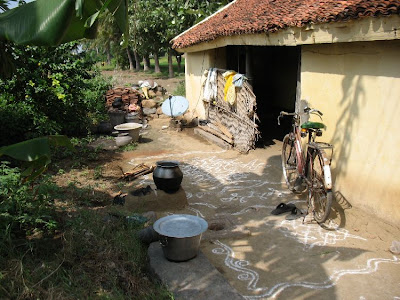Pongal was originally a Harvest Festival for the farming community but today it is celebrated by all. It follows the solar calendar and is celebrated on the same days each year. With the end of the wet month of Margazhi (mid December to mid January) the new Tamil month of Thai heralds a series of festivals.
According to the calendar based on the solar system the year is divided into two halves following the apparent movement of the Sun northwards and Southwards. The former is termed Uttarayanam and the latter is Dakshinayanam. Uttarayanam marks the Sun’s movement northward for a six month period and all important events are scheduled during this time. On the first day of Thai, the Sun leaves the zodiac sign of Sagittarius and enters that of Capricorn, the latter is known as Makaram. The event thus is celebrated as Pongal.
There is a Tamil saying; "Thai peranthal Vali Perakum" – which means - with the dawn of the month of Thai, there will be peace, happiness, prosperity, brightness and harmony in the life of everyone.
Four festivals are celebrated at Tiruvannamalai (and throughout Tamil Nadu) for four consecutive days during Pongal Festival. Bhogi Pongal on January 13th, Surya Pongal on January 14th, Maattu Pongal on January 15th, and Thiruvalluvar Day (Kaanum Pongal) on January 16.
On Bhogi old clothes and materials are thrown away and set on fire, marking the beginning of a new life. The second day of Pongal, is celebrated by boiling fresh milk early in the morning and allowing it to boil over the vessel - a tradition that is the literal translation for Pongal. The third day, Mattu Pongal, is meant to offer thanks to the cows and buffaloes, as they are used to plough the lands. The fourth day of this Festival is called Kaanum Pongal. In a few places this day is also known as Karinaal or Thiruvalluvar Day.
 |
| Decorated Nandi at Arunachaleswarar Temple, Pongal 2015 |
Today the third day is known as Mattu Pongal, on which we offer thanks to the cows and buffaloes. To look at an earlier cow pongal at Tiruvannamalai, please go to this link here.
As well as farmers and agriculturalists celebrating Mattu Pongal today, the cow (buffalo) is also worshipped at Arunachaleswarar Temple.
The Five Nandis
During Mattu Pongal at Arunachaleswarar Temple, apart from other celebrations, the five Nandis inside the Temple are lavishly decorated with garlands and foodstuff.
The five Nandis are; Pradosha Nandi, in the Moolastanam, Ratha Vilaku Nandi in the Second Prakaram, Kodi Kampathu Nandi in the Third Prakaram, Chinna Nandi in the fourth prakaram and the Periyar Nandi that stands in front of the Vallala Gopuram in the Fifth Prakaram.
 |
| Mattu Pongal Arunachaleswarar Temple 2015 |
 |
| The Gods giving darshan at Thitti Vasal Gate, Big Temple |
Also on this day and unique to Tiruvannamalai, we observe the Tiruvoodal Festival. Legend has it that the Lord in answer to a promise given to Parvati appears on this holy day (Uttarayana) to dance on one foot. He says; ‘On Uttarayana holy day, I will do the dance when the sun rises.’
The word 'Thiru' signifies; deity, sacred, holy and wealth and the word 'Voodal' actually means 'tiff' or 'petty quarrel', and represents the friction between the male and female in a love relationship which is consciously exacerbated. The distinguishing mark of Voodal is that it should arise and stay only for a brief period and not be prolonged as its focus is the bliss when the Voodal is withdrawn.
The poem Thirukkural says in the chapters dedicated to 'kama' which is concentrated on the relationship between man and woman and the establishment of household and children, that; 'The way to amplify bliss through desire or relationship is through voodal. That ever present bliss you can only see when the tension comes and is withdrawn. It is like salt to food – beyond a certain limit it is lost completely.' Thirukurral explains the tiff as 'creation of a tension, which when released you have a bliss that is always present. It is the Voodal that helps one focus upon that.'
Thus Thiruvoodal is enacted by Shiva and Parvati to convey social truths to their devotees. It takes place; inside the compound of Arunachaleswarar Temple, on the streets delineating the perimeter of the Temple, and on the girivalam pathway itself; by iconic representations of Shiva and Parvati. Thiruvoodal Festival is regarded in such high esteem that one of the perimeter roads has earned the special name Thiruvoodal Street by this convention.
To read more of this narrative please visit my website at this link here, and an earlier posting on Arunachala Grace at this link here.
















